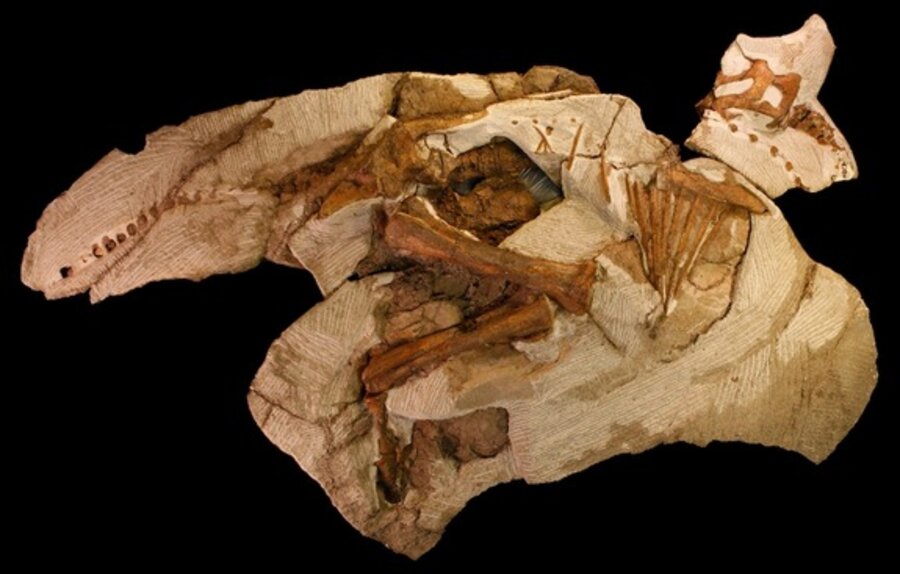High-school student finds baby duck-billed dino fossil
Loading...
A dinosaur skeleton discovered by an eagle-eyed high-school student turns out to be the smallest, youngest and most complete duck-billed dinosaur of its kind ever found.
This Cretaceous-era herbivore, Parasaurolophus, walked the Earth some 75 million years ago. The dinosaurs in this genus are best known for their impressive tube-shaped head crests, which may have been used for display or perhaps to amplify the animals' calls. The little specimen, dubbed "Joe," was so young that its crest was a mere bump on its head.
"We now understand a lot more about how Parasaurolophus grew its crest," said Andrew Farke, a paleontologist and curator at Raymond M. Alf Museum of Paleontology in Claremont, Calif. [See Photos of the Baby Dinosaur Discovery]
Kevin finds Joe
The museum is affiliated with The Webb Schools, a private high-school campus outside of Los Angeles. The students at the schools participate in paleontology fieldwork as part of their coursework, which is how student Kevin Terris came to discover "Joe" in 2009.
Farke and a group of students were prospecting for fossils in Utah's Grand Staircase-Escalante National Monument, surveying ground Farke had already covered. Terris spotted a little sliver of bone sticking out from under a boulder and alerted Farke, who thought it looked like a piece of dinosaur rib — nice, but not really worth the trouble of excavating.
"We were going to try to see if we could get something better," Farke told LiveScience.
He walked around the other side of the boulder and picked up what looked like a large cobblestone, turning it over in his hands. A dinosaur skull stared back at him.
In light of the skull, Farke thought it wise to go re-check Terris' discovery. A closer look revealed it to be a string of toe bones.
"We have the skull on one side of this boulder and the toes on the other side. That means the whole dinosaur skeleton has to be in between," Farke said. "So we got pretty excited."
Growing baby
The team had to line up permits to excavate on the public land; they returned in 2010 to dig the bones from the ground. Surrounded by an 800-pound (363 kilograms) armor of rock, the bones had to be airlifted out of the rugged backcountry by helicopter.
After 1,300 painstaking hours of cleaning, chiseling and picking, technicians revealed the fossil buried in all that stone. The completeness of the skeleton turned out to be "pretty spectacular," Farke said.
The paleontologists realized they had an amazing example of a baby Parasaurolophus on their hands. Even better, they were able to sample the baby's leg bone. As dinosaur bones grow, they develop ring patterns, much like trees.
"It didn't have any rings at all," Farke said of "Joe." "So what that shows is that this animal was under a year old when it died."
The infant dinosaur was already 6 feet (1.8 meters) long, however, an impressive feat when you consider that duck-billed dinos hatched at about the same size as a human infant. The fact that "Joe" was already sprouting a crest bump so young suggests that Parasaurolophus started growing its crest earlier than other duck-billed dinosaurs.
"It finally lets us understand how Parasaurolophus evolved that big crest, just by shifting around events in its development," Farke said.
"Joe" will go on display at the Alf museum beginning today (Oct. 22) to coincide with a publication about the discovery in the journal PeerJ. A digital exploration of the skeleton will also be available at dinosaurjoe.com.
As for Terris, the student who found the little duck-bill, he's now in college, studying geology, Farke said.
Follow Stephanie Pappas on Twitter and Google+. Follow us @livescience, Facebook & Google+. Original article onLiveScience.
- Image Gallery: Dinosaur Daycare
- Paleo-Art: Dinosaurs Come to Life in Stunning Illustrations
- The 10 Weirdest Animal Discoveries
Copyright 2013 LiveScience, a TechMediaNetwork company. All rights reserved. This material may not be published, broadcast, rewritten or redistributed.







